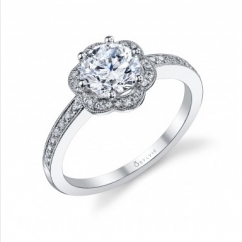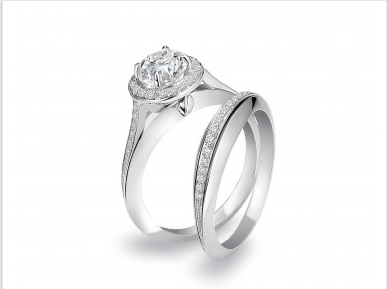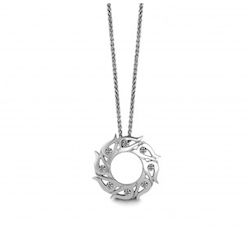Articles and News
New PGI Research Confirms Scary Online Trends For Luxury Jewelers | January 22, 2014 (0 comments)

New York, NY—New research conducted by the Platinum Guild International has confirmed what luxury jewelers are most afraid of: online shoppers are no longer just looking for the lowest price. In an exclusive interview with The Centurion, Huw Daniel, president of the Platinum Guild International in the United States, discusses the fall 2013 study findings and its implications for all luxury jewelers.
It’s no secret that growth in online shopping has outpaced brick and mortar for a long time. For holiday 2013, online sales increased 10% over 2012 figures, outperforming the growth of brick-and-mortar retail by a factor of at least two, according to digital metrics firm Comscore.
That growth is evident in fine jewelry. In overall share of online sales, jewelry sits in third place. Indeed, the average ticket for bridal rings sold online was between $6,500 and $7,000, says Daniel; about twice the average of all engagement rings, and much closer to the typical luxury jewelry store bridal sale. (According to The Knot.com, the average cost of an engagement ring was $5431 in 2013. But industry analyst Ken Gassman told The Centurion that when sales of rings at Wal-Mart and other kinds of retailers are factored in, the real average cost of a diamond engagement ring among all U.S. retailers is much lower; closer to $3,600.

Not surprisingly, the PGI survey showed platinum leads for high-end diamond-intensive jewelry, such as this bridal set from Coast Diamond. For product retailing up to $5,000, even a few hundred dollars' difference in price between platinum and white gold will make or break a sale, but PGI's survey showed price resistance to platinum vs. white gold drops significantly on higher-priced goods, where the bulk of the cost is in the diamond/s.
“With platinum especially, the playing field is leveled out online,” says Daniel. “In a retail store, platinum merchandise often is weak compared to other metals, but online sites present the design, the choice of metals, and the price, along with education.” And, he added, a lot of sites have quite good education.
“There’s a perception among consumers that online education is more objective,” he added. Indeed, Blue Nile’s Josh Holland confirmed that product education is the backbone of the e-tailer’s presentation.
“Our non-commissioned diamond and jewelry consultants give customers the facts so they can make the best choice for their style and budget,” he told The Centurion, adding that platinum is the site’s most popular metal for engagement rings and wedding bands.


This engagement and wedding band set from Blue Nile, left, was one of Nina Garcia's "platinum must haves" picks on The Knot.com, in conjunction with PGI. Garcia also tagged this sculpted set from Uneek by Benjamin Jhaveri as a "must have."
It’s an “aha” moment for luxury retailers, Daniel says. “I don’t think the story is that online is going to take all your customers; it’s that even if you have a brick and mortar store, you need some e-commerce element.”
Platinum sales have been on the upswing recently; in fact, figures from Johnson Matthey show platinum sales in 2013 grew 11%, outpacing the jewelry market as a whole, which posted a 6% gain in 2012. Part of the reason was the high price of gold, significantly narrowing the spread with platinum. The other part was the significant increase in “entry platinum,” i.e., lower price-point merchandise.
Going into 2008, platinum had hit almost $2,200 an ounce, and platinum jewelry was priced out of most categories. “The sweet spot for a semi-mount is between $1,000 and $2,500 retail,” says Daniel. Platinum, which for almost a decade had traded around $400 an ounce, fit the range. But when the price soared, it necessitated the re-engineering of many designs to bring the price point back down a level where consumers would again consider the metal. Luckily, by then design trends also had shifted toward petite design, with individualization more important than size as the primary driver of purchase.
At press time, platinum was trading at $1480 the ounce, and gold at $1,254. There’s far less price volatility now, but one of the casualties from the $2000 years is platinum fashion. Retailers destocked to the point where it’s almost non-existent, and bringing it back is a classic chicken-egg scenario.
“It’s an availability issue more than a consumer issue. You can’t sell what you don’t have,” says Daniel. PGI fields calls “all the time” from retailers asking where they can get platinum basics, but it’s a challenge to find.
“There’s lots of production in Japan, but it’s tough to get here.” And because the primary customer for platinum fashion is a Boomer customer, not a Millennial, he’s not sure how many manufacturers are motivated to get into it. And so far, he says, not that many retailers are stocking it. Tiffany does; in prices ranging from $1,500 to $10,000, but the only other place Daniel has seen a robust platinum fashion collection is online at Blue Nile.
“If retailers are afraid to stock it, customers can’t buy it, so online is plugging the gap,” he says, emphasizing that consumers are much less price-sensitive than retailers may think.


Is platinum fashion poised for a comeback? Nina Garcia chose these two platinum and diamond necklaces as "must-haves." Left, by MaeVona, and right, by Sasha Primak. Another plus: by default, most platinum jewelry sold in the United States also is made in the United States, which plays to the increasing consumer demand for products made here. President Huw Daniel says PGI doesn't promote "Made in the USA" because it's not a property of the metal itself, but added, "if I were a brand, I would probably promote that."
Making money and attracting Millennials. In 2012, PGI launched a strategic initiative to show retailers that by focusing on gross margin dollars instead of margin percentage, they actually make more money on platinum. Because of the higher price point, retailers can soften their margin and still make more dollars than they would in other categories.
It’s working, says Daniel. “Retailers are playing it back in this report.”
Still, the industry needs to come together to ensure that fine jewelry—not just platinum—is a top-of-mind category for Millennials, says Daniel. They buy bridal jewelry, but unless the industry steps up its marketing efforts across the board, he fears fine jewelry risks becoming irrelevant.
“The jewelry category is not being supported with marketing to the level that other categories are.” Without the DTC (Diamond Trading Company), there’s nobody keeping the jewelry dream alive other than the odd brand, he says. Unlike other luxury categories, there is a degree of cultural imperative for certain kinds of jewelry as life markers, he says, but the industry needs to step up and reinforce not only that but also create desire in general apart from these life markers.
It’s not impossible. Daniel points to fine watches as an example: from fearing cell phones would make them extinct, watches are now one of the strongest growth categories in the luxury market. A combination of marketing, status, and collectability has driven the turnaround.
Other findings in the PGI study weren’t big surprises:
- Responses were mixed as to whether brands increase or decrease price resistance. Some consumers will pay whatever it costs to get a brand; other retailers said some brands charge such high prices for platinum that it’s a deterrent to sales.
- The more transparent the diamond content, the lower the markup on platinum jewelry.
- Pure-play e-tailers have lower markups than other retailer types
- There’s still a threshold of fear at the bench, and PGI is working with GIA to develop platinum quality assurances for bench jewelers.
- The need for training is as important as ever, says Daniel, which is why PGI invests so much time and resources developing training tools to help associates understand and sell the metal. Retailers can find a whole range of online training modules at http://www.platinumlearning.com
Top image: Bridal set by Sylvie won PGI's Platinum Innovation Award for Entry Platinum







